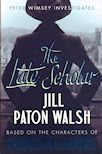Dorothy Sayers started on her fifth Wimsey/Vane novel in the late 1930s, but never finished it. When the partial manuscript and notes came to light recently -- precisely how much material there was is not clear -- detective novelist Jill Paton Walsh was given the opportunity to finish it off.
This must have been a rather daunting opportunity: she ran the risk of having all the good bits attributed to Sayers, and any bad bits to herself. As an avid Wimsey/Vane fan who would give her eye teeth for the chance to read a new Sayers original, I did start reading this with some trepidation. But my fears were allayed: there are no obvious joins, the 1930s tone is just right, the well-known characters keep in character, and no new characters obtrude. Although the story gets off to a slow start establishing the background, once the body turns up, about a third of the way through, things soon settle down into the combination of detection and relationships that we know and love. There are various threads twining through the story: the detection itself, Harriet adapting to her new married life and status, the contrast of the Wimseys' and the Harwells' marriages, Harriet's own new detective novel, and the death of the old King (hence setting it firmly in 1936). Harriet and Peter discussing her new book and the differences between such fiction and the 'real' detection in which they are engaged gives opportunity for some interesting meta-commentary on detective fiction.
I don't think it is quite as good a detective novel as the others: I spotted the killer very early on, and I never spotted the culprit so soon in the previous books. (Then again, it is over twenty years since I have read a Sayers for the first time, so maybe the change is in me?) Also, it doesn't seem to me to have quite the depth or originality as the other Wimsey/Vane books -- but if Jill Paton Walsh doesn't exhibit her literary erudition as much as Sayers did, that's okay by me, as most if it went over my non-literary head anyway. There are a lot of references to incidents in those earlier books as well, as if to emphasise the legitimacy of this work. But despite these minor carpings, this is a good book: these are continuations of the same characters, and we get to see more of their lives, to see Peter and Harriet adapting to married life without compromising their integrity.
-- D. Barrington, rec.arts.sf.written 1999
Yes. I have often wished that Caudwell, instead of Jill Paton Walsh, had been chosen to write the continuation of Thrones, Dominations. (Heck, I have even oftener wished that Caudwell would release a new novel.)Walsh doesn't seem to grasp the concept of reticence, far less that of banter.
-- Betsy Perry, rec.arts.sf.written 1999
So I can say this book isn't quite as good as the originals, and yet still say without contradiction that it is definitely worth reading. Jill Paton Walsh should be congratulated for doing such a fine job.



